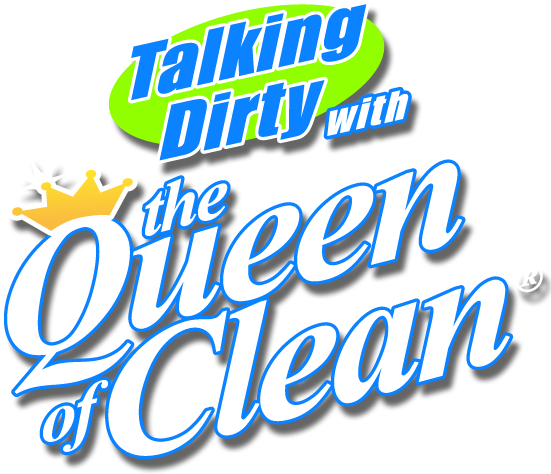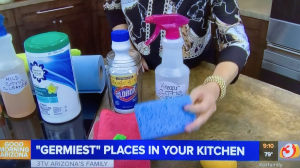CLEANING TIP SEARCH
Find your cleaning solution below
Germiest Places in your Kitchen – VIDEO
GERMIEST PLACES IN YOUR KITCHEN – As seen on 3TV/Phoenix (Good Morning Arizona) – Monday, September 30, 2019 (8:45am) and Saturday, October 5, 2019 (6:45am and 9:09am)
Watch the Broadcast Video at the bottom of this post
Microwave plate
The microwave plate is surprisingly dirty.
Why it’s gross: Your microwave’s turntable is covered in 120 times the germs of a pet toy. Some think the heat kills all of the bacteria, but it’s almost never fully clean. In fact, the strongest bacteria survive, which lets them multiply and grow resistant to heat over time.
How to clean it: Wipe down your microwave every few days to control food buildup.
For a deeper clean, wipe the inside with a non-toxic, all-purpose cleaner*. Allow it to fully dry before using.
You can boil water with lemon; the steam will kill the bacteria. Allow to sit with the microwave door closed 15 minutes or so and then wipe with paper towels.
The Kitchen Sink
Why Is It Gross?
You probably run your sponge around the sink to wash away food and other remains, but usually it is gross too! The sink is still one of the germiest places in your kitchen. With the fifth-highest amount of microorganisms in the house, the sink has a presence of coliform bacteria and yeast or mold.
How to clean it:
Clean the sink with a solution of bleach and water daily, allowing the mixture to filter down the drain. Use 1 quart of water and 1 teaspoon bleach.
Scrub the sides and bottom of the sink once or twice per week with a disinfecting cleaner*.
You can pour 1 tablespoon of bleach mixed with one quart of water down the drains and disposals weekly. Be sure not to combine the bleach with any other cleaner you are using.
Refrigerator Door Handles
Why it’s gross: You stop in the middle of preparing a meal to grab something from the refrigerator. Many times you have not washed your hands after handling raw meat and foods.
How to clean it: After dinner, during your cleanup, use a natural disinfecting spray* and microfiber cloth to wipe down the handle.
Dish Drainers
Why it’s gross: It sits for weeks in one of your sinks or on the counter. Often times you sit things in it to drain and it’s stays wet frequently.
How to clean it: Put it in the dishwasher weekly or wash it in a sink of hot soapy water. Spray with white vinegar and let it dry.
Rubber Spatulas
Why it’s gross: Many rubber spatulas have two parts, the paddle and handle. If you don’t separate them each time you clean it, bacteria can build up around the edges, which could spread to food.
How to clean it: Some spatulas are easier to separate. Either wash them by hand in hot, soapy water or put them in the dishwasher. Allow the parts to dry before reassembling. Or, if you’re due for a new spatula, consider buying the silicone version that’s all one piece. No nooks and crannies.
Wooden Spoon and Utensils
Why it’s gross: Wood utensils absorb water and bacteria. They can mold, split and retain cooking residue.
How to clean it: Use a dish washing liquid and the hottest water possible to thoroughly wash wooden utncils. Do not allow to soak in water.
Occasionally rinse with white vinegar to kill germs.
Don’t wash in the dishwasher
Dispose of if you see black spots which are usually mold
When buying new look at bamboo instead.
Fruit bowl
Beware of your fruit bowl — if it hasn’t been cleaned.
Why it’s gross: The fruit bowl is 163 times dirtier than eating straight from the kitchen sink. When fruits aren’t clean, or they rot in the bowl, bacteria spread onto new fruit.
How to clean it: Clean the bowl with soap and water, or put it in the dishwasher. Do this prior to every time you restock the bowl.
Salt and pepper shakers
Why they’re gross: Often you keep them by the stove and then handle them, often with dirty hands, including times you have handled raw meat.
Clean the outsides with hot soap and water every few days.
Watch the Broadcast Video (click on the video to watch)


